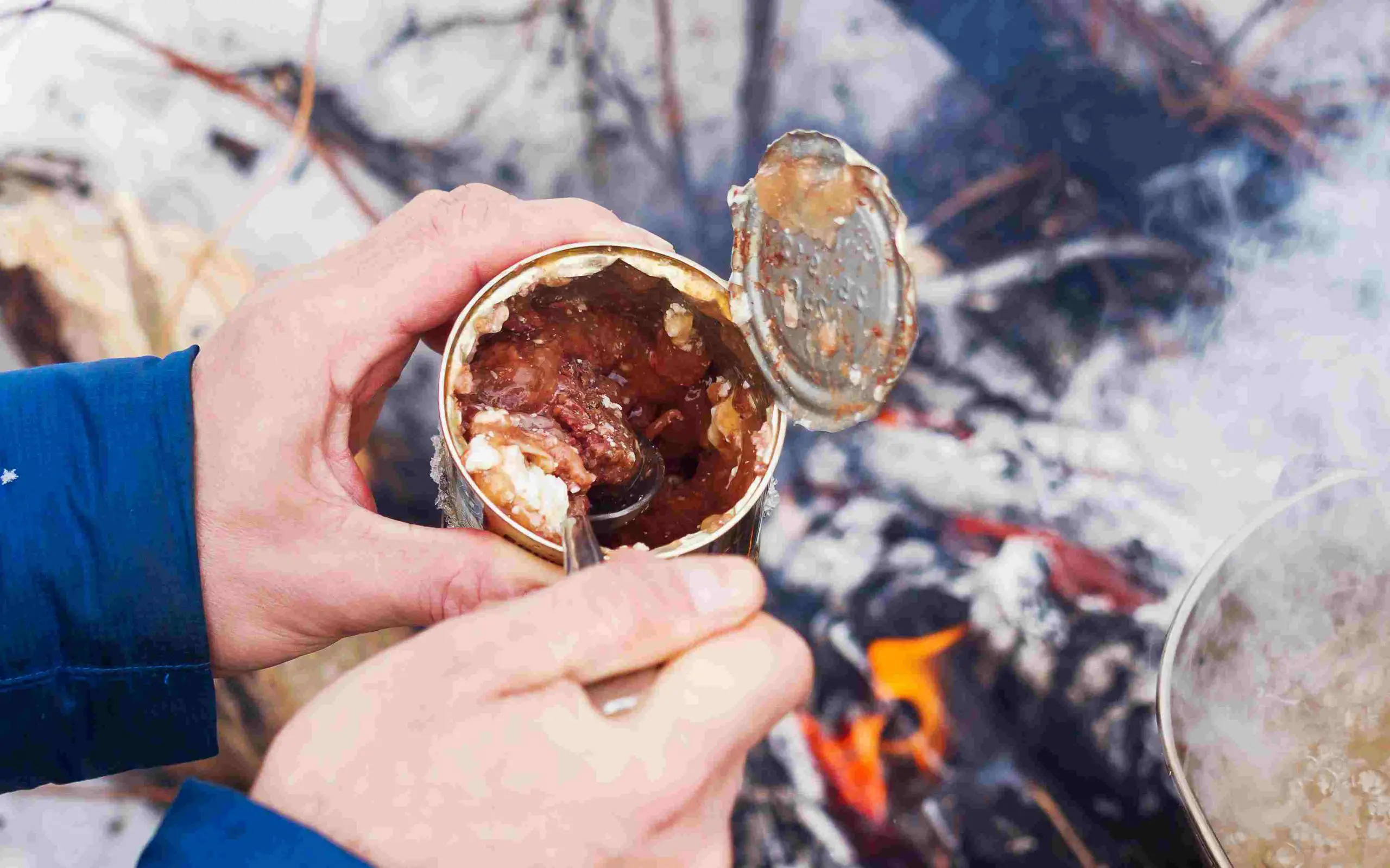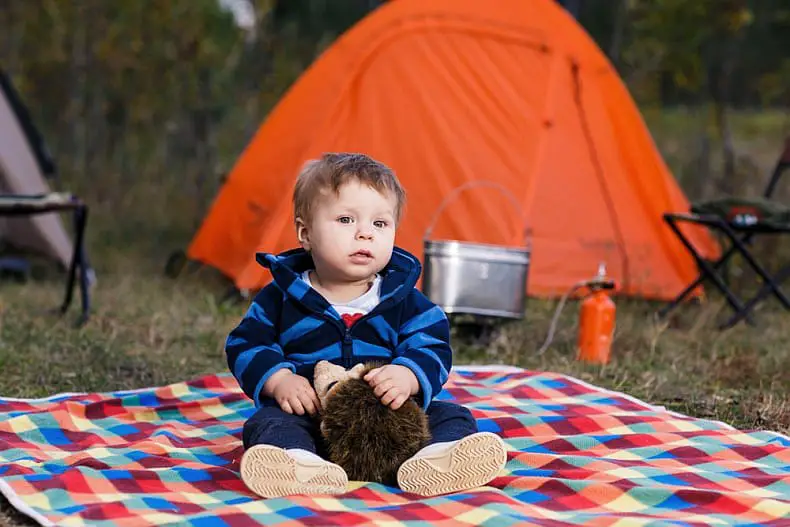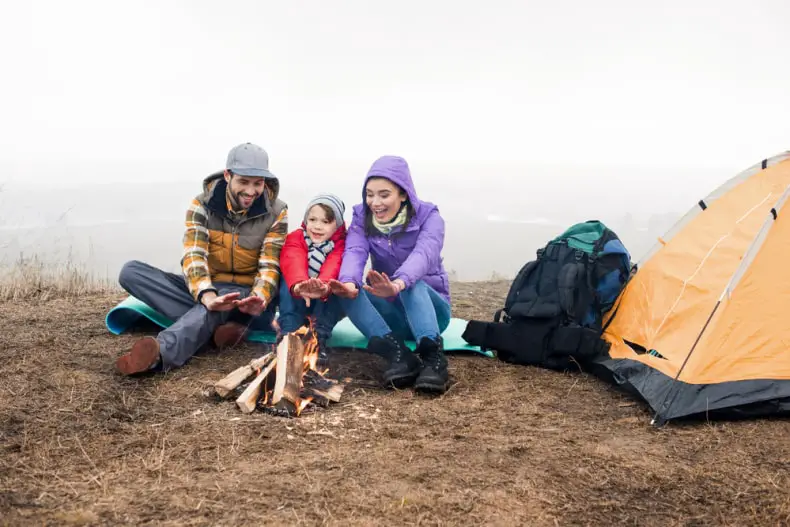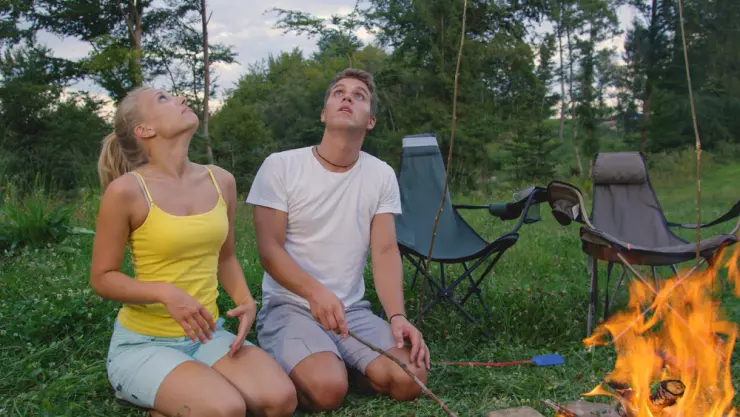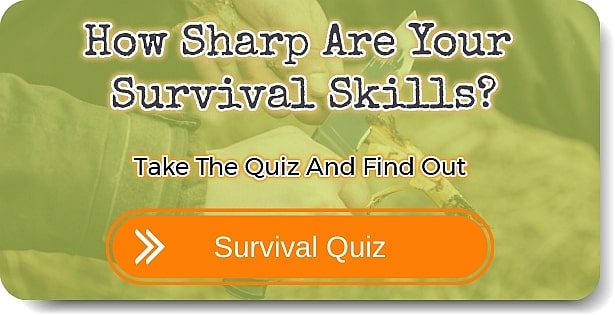Boiled water is an everyday staple that we couldn’t live without – and this doesn’t change when camping. In fact, boiling water can sometimes be even more essential on a camping trip, especially when you don’t have a water purifier on hand. It’s also great to know that you can warm up with a nice cup of coffee in the mornings, rehydrate meals easily, or sip hot tea from a flask throughout the day.
There are lots of benefits to learning how to boil water while camping, and in this article, we explore 5 different methods for doing it. As we offer an easy step-by-step guide for each method, the pros and cons, as well as some handy tips and tricks, you’ll have no problem finding the method that best suits you!
Table of Contents
5 Ways To Boil Water While Camping
When you need to boil water while camping, there isn’t necessarily a one size fits all solution. Different campers will have different equipment and resources, which means that some methods may not be realistic for you. You may also be wondering which method of boiling water is the quickest or easiest, and which equipment to invest in to take on your trip.
In this article, we explore 5 different methods, ranging from more traditional solutions that utilize campfires or portable camping stoves, to solar water heating bags and internal flames kettles.
The methods are:
- Using a campfire
- The bucket heater method
- Using a portable camping stove
- Solar water heating bags
- Boiling water over an internal flame (volcano) kettle
Boil Water Using A Campfire
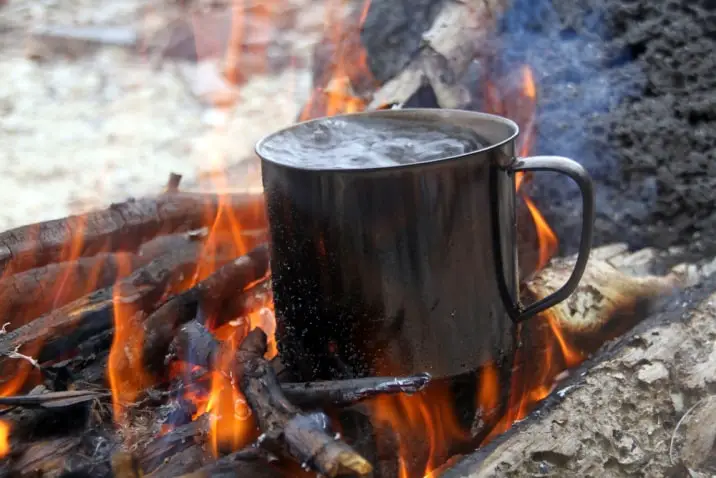
One of the most common ways to boil water when camping is to use a campfire. However, this method is only convenient if you are already intending on building an open fire, and it will require you to have a grill. Campfires are typically used to boil water on hiking or backpacking trips. If you have everything you need for this method to work, it can be an incredibly easy way to boil water as it simply involves pouring water into a metal bucket and allowing it to heat around the fire.
How to start a campfire:
- Gather enough tinder, kindling, and firewood for a successful fire, and make sure you have matches or a lighter to hand (gas lighters used to light grills are also becoming an increasingly popular option).
- Build your fire by laying a bed of tinder, laying your kindling, building up with smaller pieces of firewood, and topping off with some lighter kindling.
- Keep pets and children away as you light your tinder on several sides, remembering to never squirt charcoal lighter fluid into a fire or use gasoline.
Although this is an easy and convenient method to boil water if you already have a campfire, it’s not the best way. This is because the heat of a campfire can be hard to control and often unreliable, meaning it can take longer for the water to reach a boiling point. For this reason, it can be a big waste of time to build a campfire just to boil water, and there are lots of other methods that you may find more convenient.
Using The Bucket Heater Method

In scenarios where you need a large amount of heated water (such as for a bath), this method is a great option on the list that’s easy to use. It won’t get you boiled water but it will get it close.
A bucket heater is essentially a heating element with a stainless steel guard that heats the water close to boiling when you submerge it into a bucket of water. This method will require an existing power outlet at your campsite or a portable generator that you can use to power your bucket heater. If you have all the necessary resources, the bucket heater method is a fast and reliable way to get hot water fast.
Requirements:
- Pour water into the bucket.
- Connect the bucket heater to a power outlet and submerse in the bucket of water. Allow the element to heat the water for several minutes.
- Once the water reaches the desired temperature, disconnect the bucket heater from the power source, and use as you wish.
It’s quick and easy, but only truly convenient and worthwhile when embarking on large family camping trips where large amounts of water are necessary. This method will heat water beyond 150º F.
Boil Water With A Portable Camping Stove
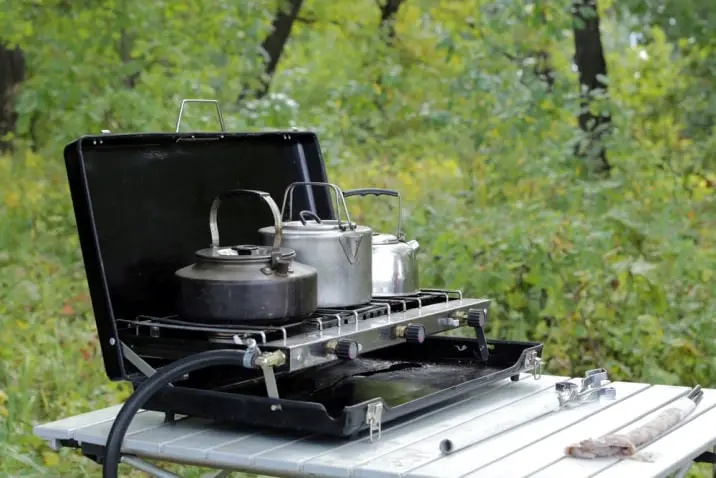
Any experienced camper worth their salt will have a portable camping stove in their arsenal, it’s essential for making quick meals and can also be a handy way to boil water. Aside from the portable stove itself, this method also requires a small pot and a lighter.
This ridiculously simple method is complete in just a couple of short steps:
- Light the camping stove and place your pot of water on it.
- Adjust the temperature to help your water boil faster.
Typically this method is only capable of boiling a smaller amount of water, larger amounts may take far too long to be convenient. However, when it comes to providing quick meals and cups of tea and coffee for your co-campers this method will work fantastically.
One of the most recognized propane camping stoves is the Coleman Two-Burner gas camp stove. Great not just for cooking up most any meal you desire while camping, boiling water is a cinch. It comes with two adjustable burners and can cook for one hour on a single 16.4-ounce propane cylinder.
Boil Water Faster With A Canister Stove
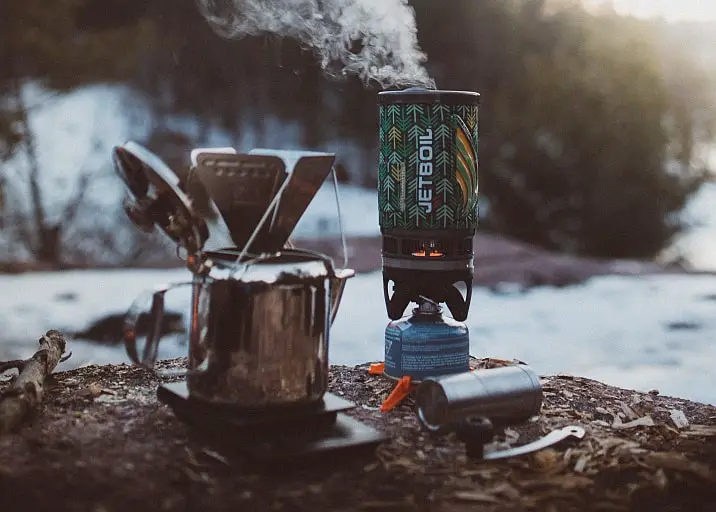
The best way to boil water quickly is to use a canister stove. Canister stoves such as a Jetboil Flash or MSR PocketRocket® are compact and are a favorite for backpackers because they are ultra-light and take up so little space. This type of camping stove is fueled with a canister containing an isobutane/propane mixture. The stove portion simply screws onto the canister and is ready to light. Canister stoves can have a super-fast boil time – in as little as three minutes which makes them a favorite camping stove among campers and backpackers.
Solar Water Heating Bags
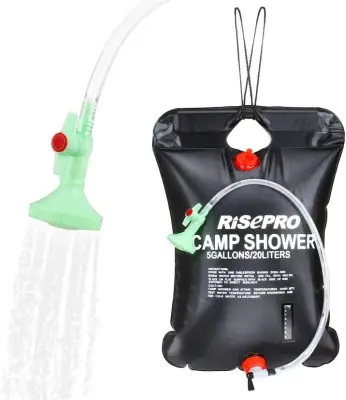
The solar water heating bag method is a great idea for eco-friendly campers or just those that want a reliable method to heat water. This method may be especially attractive to those that don’t want to start a fire or use lighters, as the heat is powered by solar energy. It’s an incredibly easy method, only requiring you to fill the bag with water and allow the bag to absorb solar energy to heat the water. Although you won’t have boiled water, it will heat it suitable for showering, washing dishes, etc.
To heat water with a solar water heating bag, follow these steps:
- Fill your solar water heating bag with water.
- Hang the bag in direct sunlight.
- Wait about 3 hours or so for the water to heat up.
Although this is a versatile and simple method for heating water, you should note that its efficiency will depend on the surrounding conditions. Pay close attention to your heating bag’s instructions.
Boiling Water With An Internal Flame Kettle (Volcano Kettle)
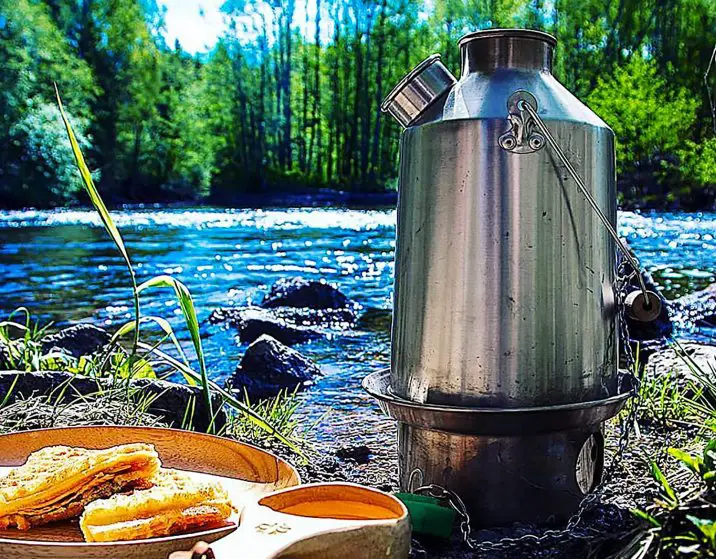
If you’re looking for another quick and easy way to boil water when camping, an internal flame kettle (also known as a volcano kettle, Ghillie Kettle or Kelly Kettle) may be a solid investment to make before your trip. Typically, internal flame kettles are well-priced, making them a cost-effective addition to your arsenal. Their compact shape also makes them easy to pack, and their reliable nature means that you won’t regret taking one on your trip.
An internal flame kettle doesn’t require electricity or batteries, instead, the camper can burn organic materials found around their campsite in a special internal chamber that keeps the fire burning (even in strong winds!). Thus, this method can be more convenient than a campfire when it comes to windy weather conditions.
The kettle is essentially a chimney that allows the heat from the fire to pass all the way through the top. The thin wall around the chimney portion is where the water resides so it gets heated from the entire inside of the kettle – not just the bottom. This makes it very efficient at heating water.
These kettles come with their own vented base for building a tiny fire underneath and then easily detach when the water is ready.
How do I use a volcano kettle?
- Fill your kettle with water
- Use sticks and other natural debris from around your campsite to light a fire inside the kettle.
- In 3-5 minutes your water will be boiling and ready to use!
It’s a really simple, quick, and effective method, ideal for situations where you require a weather-proof solution, and the spout on the kettle also makes it perfect for making hot drinks such as tea and coffee.
Which Water Boiling Method Is Best For Me? The Pros and Cons
Each one of the five methods we’ve explored in this article holds its own range of pros and cons. It’s a good idea to weigh up these pros and cons for yourself before deciding on which is the best method for you when you need to boil water on your camping trip. If you were looking for a quick, easy-to-read summary of each of the options, this section may also be useful for you!
[callout]
Over a campfire
Pros:
- An age-old method for boiling water on a camping trip.
- Convenient and easy if you already have an open fire built for other purposes.
Cons:
- This method is not worth the time and effort of building a campfire just to boil water.
- It will also require a grill.
The bucket heater method
Pros:
- The best method for producing large amounts of hot water.
- A fast and reliable method to boil water while camping.
Cons:
- Requires power, either from an outlet or generator.
- A stainless steel bucket protector is recommended to prevent the bucket from melting in the heat.
- Does not boil water.
Using a portable stove
Pros:
- Portable stoves are already a camping essential, so you probably are already taking one on your trip.
- This method produces an adequate amount of boiling water in two short steps.
Cons:
- This method is only capable of producing smaller amounts of water, ideal mainly for things like tea, coffee and quick meals.
Solar water heating bags
Pros:
- A reliable and eco-friendly method for heating water.
- The bag can be reused again and again on your trip.
- Convenient to carry while hiking.
Cons:
- Relies heavily on the weather.
Volcano kettle
Pros:
- Quick and easy, requiring only organic debris from the surrounding campsite to create a fire that boils water.
- The insulated kettle means that the fire is weather-proof, so you can produce boiling water reliably.
Cons:
- May not be the most convenient equipment to carry while hiking.
[/callout]
Tips And Tricks For Boiling Water While Camping
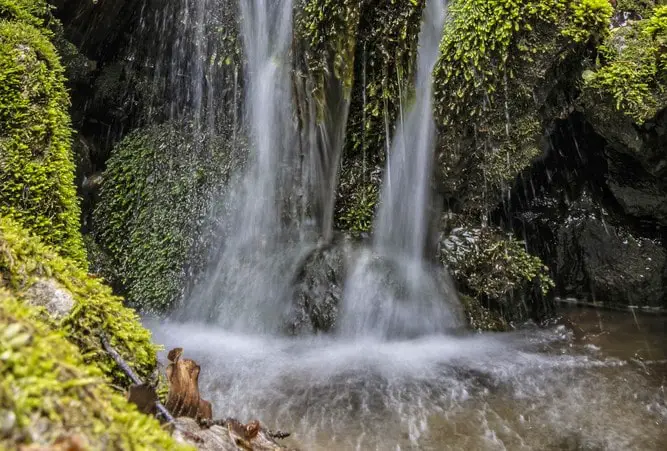
Boiling water at home is such a standard procedure that we often don’t think twice about it, yet once we’re out in nature this all changes as we’re using water that has come from a natural source and has not been purified. Here we run through some of our top tips and tricks for boiling water safely and successfully, such as where to get your water, and how to avoid any accidents.
- Know where your water is coming from
If you are using water from a natural source while out camping, it can be vital that you know exactly where it is coming from. Many inexperienced campers wrongly assume that boiling water will rid it of all impurities and hazards, however, boiling the water will not remove any toxic chemicals. The solution to this is either to fully trust that your water source has no toxic chemicals or to carry a specialized water filter that can get rid of these toxic chemicals for you.
- Avoid stagnant water at all costs
Stagnant water is never a good idea, especially when it comes to drinking. While looking for your water source, look for the water that is flowing as fast as possible. You can find fast-flowing water by heading upstream near flowing water or areas of human activity.
- Filter your water before boiling
If you are using water from a stream, it is highly likely that it contains dirt and sediment – you’ll need to filter this out as best as possible before boiling the water. You can use a portable backpacking filter for this. Some campers simply use a clean cloth to filter their water before pouring it into their kettle, pot, or solar water heating bag to boil.
- Bring water to a rolling boil
Your water should be at high heat for as long as possible to ensure all bacteria and pathogens have been killed and the water is safe to drink. When boiling your water, aim to bring it to a rolling boil for at least one full minute.
- The higher you are, the longer you should boil
If you are hiking and camping in a mountainous region with a high elevation, you should bring your water to a rolling boil for even longer (aim for around 3 minutes at a rolling boil). This is because water boils far quicker at a lower elevation, and while higher up you want to ensure your water is as safe to drink as possible.
- Boil water away from your tent
Especially when the wind is unpredictable, make sure that you are boiling your water at a safe distance from your tent and any equipment – not only to protect the safety of you and your belongings but also to avoid any unnecessary wildfires.
- Have a first aid kit on hand
Any good camper knows that they should always have a first aid kit on hand throughout their trip, and this is especially true when boiling water. When working with hot objects and liquids, it can be easy to have an accident and end up with a burn. Make sure you have burn cream and dressings in your first aid kit ready to deal with any accidents calmly.
How To Brew The Perfect Cup Of Coffee While Camping
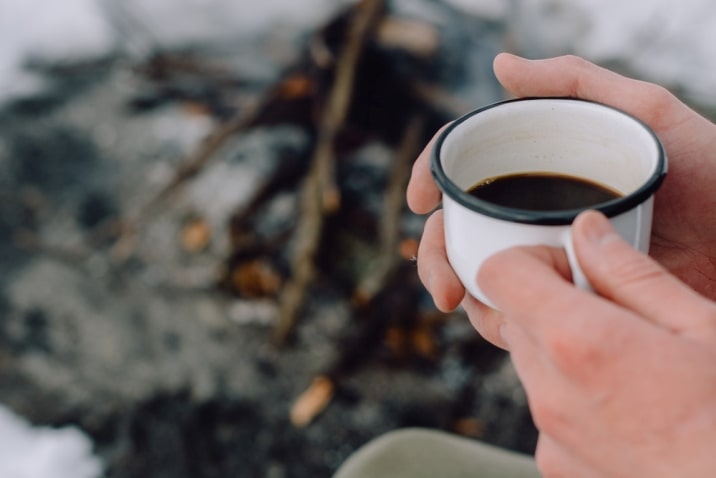
As we said earlier in the article, there are lots of uses for boiling water while camping, but one of the most popular is definitely a cup of hot coffee to kick-start your day or to warm up in the evening. Here we’ve included a fail-safe guide to make coffee while camping, so you don’t have to miss out on one of your favorite home comforts!
Using Ground Coffee
If you’re using ground coffee to make coffee, this method will ensure you get a perfect balance – no matter which method you’re using to boil your water.
Begin with half a cup of freshly ground coffee, combining it with six cups of cold water in whatever vessel you are using to boil your water. Heat the mixture gently until it reaches a soft boil. Remove the mixture from the heat and leave to stand for 3 minutes before adding a splash of cold water. This method generally produces very strong coffee, perfect to wake up to in the morning!
Another way to make coffee while camping (and a favorite with coffee connoisseurs!) is to use fresh beans. This is a real treat, providing all of the same rich flavors that we’re used to at home. Pack your favorite coffee beans in an airtight container, and never place them in a fridge or freezer where they could lose their unique flavor.
When you’re ready to make coffee, grind your beans with a portable hand grinder – leaving the ground beans coarse to obtain a smoother flavor. Now place a coffee filter in a cone and add 3-4 teaspoons of ground beans per cup, now pour over your boiling water and wait until it filters through into the cup.
Conclusion
Hopefully, we’ve answered your questions about boiling water while camping, and also provided some insight into the various methods available. With the right knowledge and equipment, camping can be a fun way to enjoy nature and spending time with friends or family.
We’ve shown you several ways to boil water. Once you’ve chosen the water boiling method that sounds the most convenient for you, you should have no problems having hot water whenever you want.



